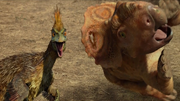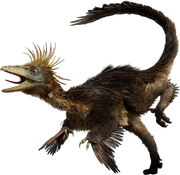The Troodonts are a group of paravina, in general they were small and not fierce. The oldest troodonts date to the late Jurassic period and the last died-out during the K/T extinction.

Troodonts remains are found on all northern hemisphere continents.
Facts[]
During most of the 20th century, troodontid fossils were few and scrappy and they have therefore been allied, at various times, with many dinosaurian lineage, particularly Pachycephelosaurs. More recent fossil discoveries of complete and articulated specimens (including specimens which preserve feathers, eggs and embryos, and complete juveniles), have helped to increase understanding about this group. Anatomical studies, particularly studies of the most primitive troodontids, like Sinovenator, demonstrate striking anatomical similarities with Archaeopteryx and primitive dromaeosaurids, and demonstrate that they are relatives comprising a clade called Paraves.

Troodon.
Troodonts also have the retractable claw on the second toe of each foot, just like Dromaeosaurs, except smaller and less sharp.
In Walking with... series[]
Walking with Dinosaurs 3D[]
Troodon played a minor but important role in the film. One of them caught and tried to eat Patchi, but was scared away, leaving Patchi with a hole in his crest instead.
Appearances in other media[]
Prehistoric Park[]
This dinosaur appeared in the last episode of the show. A group of them followed Nigel Marven and his team to the Deinosuchus lake, where they ate the meat for the Deinosuchus trap. Later, one of them followed Nigel back to the park, startling Bob and causing a stampede, until it was captured.
Another genus of troodont called Mei appeared in a previous episode, these were seen as troublemakers for Nigel and his team as they ransacked their camp and stole the human's food supply, Nigel later came across a group curled up in the ground, which he at first thought they were sleeping but discovered they were actually killed by volcanic gases. It should be noted that the Mei were contemporaries with Microraptor and were scaly, both of which are false.
